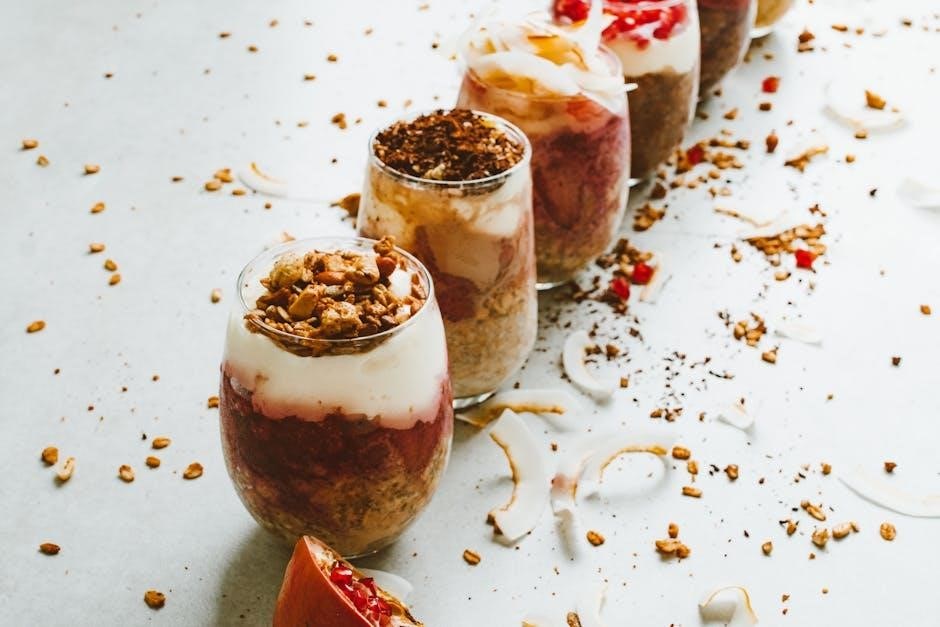
Drying time charts for dehydrators provide essential guidelines for preserving foods effectively. They outline optimal temperature, duration, and moisture levels, ensuring efficiency and food safety. These charts are vital for achieving consistent results and preventing under or over-drying, making them indispensable for both beginners and experienced users. By following these charts, you can tailor your dehydration process to specific foods, ensuring the best texture, flavor, and nutritional retention. This guide will explore how to use and customize these charts for various ingredients, helping you master dehydration like a pro.
Overview of Dehydrator Usage and Importance of Drying Time Charts
Dehydrators are essential tools for preserving food by removing moisture, preventing spoilage, and retaining nutrients. They offer precise temperature control and airflow, making them ideal for drying fruits, vegetables, meats, and herbs. Drying time charts, such as the “Tableau Temps de Séchage Déshydrateur PDF,” provide detailed guidelines for achieving optimal results. These charts list recommended temperatures, durations, and slice thicknesses for various foods, ensuring dehydration is done safely and efficiently. By following these charts, users can avoid under-drying, which may lead to mold, or over-drying, which can compromise texture and flavor. They also help users adapt to environmental factors like humidity and airflow, ensuring consistent outcomes. For both beginners and experienced users, these charts are invaluable for mastering the dehydration process and enjoying high-quality, homemade dried foods year-round.
What is a “Tableau Temps de Séchage Déshydrateur PDF”?
A “Tableau Temps de Séchage Déshydrateur PDF” is a detailed guide or chart designed to help users optimize food dehydration. It provides specific time and temperature recommendations for various foods, ensuring safe and effective drying. This document is typically available in PDF format, making it easy to download and reference. It includes information on factors like slice thickness, airflow, and humidity, which influence drying times. The chart is especially useful for beginners, as it offers a clear roadmap for achieving perfectly dried results. Additionally, it helps experienced users refine their techniques and adapt to different environmental conditions; By following the guidelines in the “Tableau Temps de Séchage Déshydrateur PDF,” users can preserve nutrients, avoid spoilage, and enjoy high-quality dried foods consistently.

Factors Affecting Drying Times in Dehydrators
Temperature, humidity, slice thickness, and airflow significantly influence drying times. These factors interact to determine efficiency and consistency, ensuring optimal food preservation and quality in dehydration processes.
Temperature and Its Impact on Drying Time
Temperature plays a critical role in determining drying times for dehydrators. Higher temperatures generally reduce drying time by accelerating moisture evaporation, while lower temperatures preserve nutrients but require longer durations. However, excessive heat can lead to over-drying or damage to food, especially delicate items like herbs. Optimal temperature ranges vary by food type, with fruits and vegetables typically requiring 135°F to 155°F (57°C to 68°C), while meats may need higher settings for safety. Consistent temperature control ensures even drying, preventing undercooked or burnt areas. Referencing a tableau temps de séchage déshydrateur PDF provides specific guidelines for precise temperature settings, balancing efficiency and food quality. Adjusting temperature based on food type and thickness is essential for achieving the best results in dehydration.

Humidity Levels and Their Role in the Drying Process
Humidity levels significantly influence the drying process in dehydrators. High humidity slows down evaporation, extending drying times, while low humidity accelerates moisture removal. Maintaining optimal humidity ensures efficient drying and prevents mold growth. If the air is too moist, food may retain excess moisture, leading to spoilage. Conversely, overly dry conditions can cause food to become brittle or over-dehydrated. Dehydrators often include humidity controls to manage this balance. Using a tableau temps de séchage déshydrateur PDF, you can determine ideal humidity settings for specific foods, ensuring the best results. Monitoring humidity alongside temperature helps achieve consistent drying outcomes, preserving food quality and safety. Proper humidity management is crucial for achieving perfectly dried foods, whether fruits, vegetables, or meats, and for maintaining their nutritional value and texture.
Thickness of Slices and Uniformity in Drying
The thickness of slices plays a crucial role in achieving uniform drying. Thicker slices retain more moisture, requiring longer drying times, while thinner slices dry faster but risk becoming brittle. Uniformity ensures consistent results, as uneven slices can lead to under-dried or over-dried areas. A tableau temps de séchage déshydrateur PDF provides guidelines for optimal slice thicknesses, helping to avoid common issues like spoilage or texture loss. Proper slicing techniques and arranging slices evenly on dehydrator trays are essential for uniform airflow and moisture evaporation. Monitoring the drying process and flipping slices as needed further enhances uniformity. By adhering to recommended thicknesses and practices, you can achieve perfectly dried foods with optimal texture and flavor. This attention to detail ensures that your dehydration efforts yield consistent, high-quality results every time.
Airflow and Its Influence on Drying Efficiency
Airflow is a critical factor in dehydration, directly impacting drying efficiency. Proper air circulation ensures even moisture removal, preventing hotspots and under-dried areas. A tableau temps de séchage déshydrateur PDF highlights the importance of maintaining consistent airflow, which accelerates the evaporation of moisture from food surfaces. Dehydrators with built-in fans enhance airflow, significantly reducing drying times compared to passive methods. However, overcrowding trays can impede airflow, leading to uneven drying and longer processing times. To optimize airflow, foods should be arranged in a single layer, and trays should not be overloaded. Additionally, some dehydrators allow for adjustable fan speeds, enabling fine-tuned control over the drying process. By prioritizing airflow, you can achieve faster, more efficient drying while preserving the quality and texture of your foods. This principle is essential for mastering dehydration and ensuring consistent results.

Food-Specific Drying Times
Different foods require specific drying times to ensure optimal preservation. Fruits, vegetables, meats, and herbs each have unique guidelines. Factors like thickness, moisture, and temperature influence timing, ensuring best results.
Fruits: Drying Times and Best Practices
Drying fruits requires careful timing to preserve their natural sweetness and texture. Most fruits dry best between 135°F and 155°F (57°C to 68°C). Thinly sliced fruits like strawberries and bananas typically dry in 6-8 hours, while thicker slices of apples or pineapples may take 8-10 hours. Berries, such as blueberries or raspberries, dry faster, often within 5-7 hours due to their small size. To ensure even drying, slice fruits uniformly and avoid overcrowding trays. Pre-treating fruits with lemon juice or a short blanching can prevent browning and retain vibrant colors. Store dried fruits in airtight containers to maintain freshness. Always refer to a tableau temps de séchage déshydrateur PDF for specific guidance tailored to your dehydrator model and the type of fruit you’re preserving.
Vegetables: Optimal Drying Times and Methods
Vegetables require precise drying times to retain their nutrients and texture. Most vegetables dry best at temperatures between 125°F and 145°F (52°C to 63°C). Root vegetables like carrots and beets typically take 7-9 hours, while softer options like zucchini or spinach may dry in 5-7 hours. Blanching vegetables before drying can help preserve color and nutrients, especially for broccoli and green beans. Slice vegetables uniformly for consistent results and avoid overcrowding trays. Herbs like kale or spinach can be dried in 3-5 hours for crispy snacks. Always monitor the drying process to prevent over-drying. For specific guidance, consult a tableau temps de séchage déshydrateur PDF, which provides detailed charts for various vegetables. Proper drying ensures vegetables remain flavorful and nutritious for long-term storage.

Meat and Poultry: Safe Drying Practices and Times
Drying meat and poultry requires careful attention to temperature and time to ensure safety and quality. Beef, turkey, or chicken strips typically dry at 160°F (71°C) for 3-4 hours, while ground meats may take 4-5 hours. Always slice meat thinly and evenly for consistent drying. To enhance flavor and texture, marinate meats before drying. For jerky, ensure the internal temperature reaches 160°F (71°C) to prevent bacterial growth; Poultry, like chicken or turkey, should be dried until crispy, usually within 4-6 hours. Refer to a tableau temps de séchage déshydrateur PDF for precise guidelines. Avoid overcrowding trays and monitor the drying process closely to achieve the perfect texture. Properly dried meats and poultry can be stored for months, making them a great snack for on-the-go. Always prioritize food safety to avoid contamination and spoilage.
Herbs: Quick Drying for Preservation
Drying herbs is a quick and effective way to preserve their flavor and aroma. Most herbs like basil, rosemary, and thyme dry best at low temperatures, typically between 95°F (35°C) and 115°F (46°C), to prevent loss of volatile oils. Drying times range from 1 to 4 hours, depending on the herb’s moisture content and thickness. For delicate herbs like parsley or dill, shorter times are recommended to retain color and potency. Always pat herbs dry before dehydration to remove excess moisture. Store dried herbs in airtight containers to maintain freshness. Refer to a tableau temps de séchage déshydrateur PDF for specific guidelines. Regularly check the herbs during the drying process to ensure they reach a crisp texture without overdrying. Properly dried herbs can be used year-round, adding fresh flavor to various dishes. This method is ideal for home gardeners and culinary enthusiasts alike.
Creating a Drying Time Chart
Developing a drying time chart involves testing various settings and recording results. Customize it for different foods and dehydrators to ensure efficiency and safety. This chart helps preserve nutrients and flavor, serving as a quick reference for all dehydration projects.
Steps to Develop a Personalized Drying Time Chart
Creating a personalized drying time chart begins with researching typical guidelines for your dehydrator model and the foods you plan to dry. Start by listing the foods you commonly dehydrate, such as fruits, vegetables, meats, and herbs. Next, conduct initial drying tests, noting the temperature, time, and thickness of slices. Record the results in a spreadsheet or notebook, paying attention to how each food responds to different settings. Over time, analyze the data to identify patterns and adjust your chart accordingly. Refine the chart by incorporating environmental factors like humidity and airflow, which can influence drying efficiency. Finally, update your chart regularly as you gain more experience and experiment with new recipes or techniques. This personalized approach ensures consistent results and optimizes your dehydration process for various ingredients and conditions.

Using a Dehydrator to Measure and Record Drying Times
Using a dehydrator to measure and record drying times is a straightforward process that ensures precise results. Start by setting the dehydrator to the recommended temperature for your food type. Use a timer to track the drying duration, checking periodically to monitor progress. For accuracy, slice foods uniformly and place them in a single layer on the trays to ensure even drying. Consider using a food thermometer to verify internal temperatures, especially for meats and poultry. Record the time, temperature, and food thickness in a notebook or digital spreadsheet. Note any observations, such as crispiness, chewiness, or dryness, to refine future batches. Over time, this data will help you create a personalized drying time chart tailored to your dehydrator and preferences. Consistent recording ensures reproducible results and optimizes the dehydration process for various ingredients.
How to Adjust Drying Times Based on Environmental Factors
Environmental factors significantly influence drying times, requiring adjustments for optimal results. Temperature plays a crucial role; higher temperatures generally reduce drying time, while lower temperatures increase it. Humidity levels also impact drying efficiency, as high humidity slows moisture evaporation. To compensate, increase the dehydration time or temperature slightly. Airflow is another critical factor—ensure proper air circulation around the dehydrator to maintain efficiency. Additionally, the thickness and moisture content of food slices can vary, affecting drying times. Monitor the drying process regularly and adjust the time based on the food’s texture and dryness. For precise control, use a thermometer and hygrometer to measure environmental conditions. By adapting to these variables, you can achieve consistent results and preserve foods effectively. Record these adjustments in your drying time chart for future reference and improved accuracy.

Common Mistakes to Avoid
Common mistakes include overloading trays, uneven slice thickness, and neglecting to monitor progress, leading to poor results. Avoid these errors for successful dehydration outcomes.

Overloading the Dehydrator Trays
Overloading dehydrator trays is a common mistake that can significantly hinder the drying process. When too much food is placed on the trays, it restricts airflow, leading to uneven drying and potentially undercooked or overcooked areas. This can result in longer drying times and may even cause the growth of harmful bacteria due to incomplete dehydration. Additionally, overloaded trays can cause food to stick together, making it difficult to separate and store properly. To avoid this, always follow the manufacturer’s guidelines for tray capacity and ensure food is spread out evenly. If necessary, use multiple batches to accommodate larger quantities. Proper spacing allows for consistent air circulation, which is crucial for efficient and safe dehydration. By avoiding overcrowding, you can achieve better results and maintain the quality of your dried foods.
Incorrect Slice Thickness and Its Effects

Incorrect slice thickness is a common mistake that can negatively impact the dehydration process. Uneven or overly thick slices can lead to inconsistent drying, where some parts remain moist while others become overly dry. This can result in a loss of texture and flavor, as well as potential spoilage due to incomplete dehydration. Thicker slices require longer drying times, which may cause thinner slices to become brittle or develop an unpleasant texture. To avoid this, it’s essential to slice foods uniformly, following the guidelines in your drying time chart. Using a mandoline slicer or sharp knife can help achieve consistent thickness. Additionally, referring to a tableau temps de séchage déshydrateur PDF can provide specific recommendations for various foods, ensuring optimal results. Always double-check slice thickness before placing foods in the dehydrator to guarantee even drying and preserve the quality of your final product.
Not Monitoring the Drying Process
Failing to monitor the drying process can lead to suboptimal results, such as over-dried or under-dried foods. Dehydration is a delicate process where even slight variations in temperature or humidity can affect outcomes. Without regular checks, it’s easy to miss the ideal dryness level, resulting in food that’s either too crisp or still soggy. Over-dried foods lose their flavor and texture, while under-dried foods may develop mold or spoilage. To avoid this, refer to a tableau temps de séchage déshydrateur PDF for time guidelines, but also check food periodically during the process. Rotate trays for even drying and adjust settings as needed. Proper monitoring ensures the best preservation of nutrients, flavor, and texture, making the effort worthwhile for high-quality dried foods. Consistent oversight is key to achieving consistent and delicious results every time.
Practical Tips for Effective Drying
Ensure uniform slices, maintain proper airflow, and monitor temperature consistently. Refer to a tableau temps de séchage déshydrateur PDF for precise timing and adjust as needed for optimal results.
Pre-Treatment of Foods Before Drying
Pre-treating foods before drying is crucial for achieving optimal results. Techniques like blanching, steaming, or soaking can inactivate enzymes, preserve color, and enhance flavor. For fruits, a brief dip in lemon juice or ascorbic acid prevents browning. Vegetables may require blanching to retain vibrant colors and nutrients. Meats should be marinated or seasoned to ensure tenderness and flavor retention. Herbs can be rinsed and patted dry to remove moisture. Consulting a tableau temps de séchage déshydrateur PDF provides specific pre-treatment guidelines for various foods, ensuring consistency. Proper pre-treatment not only improves the drying process but also guarantees better texture and longer shelf life for dried foods.
Storage of Dried Foods for Longevity
Proper storage is essential for maintaining the quality and longevity of dried foods. Use airtight, moisture-proof containers like glass jars or vacuum-sealed bags to prevent exposure to air, moisture, and pests. Store containers in a cool, dark place, such as a pantry or cupboard, away from direct sunlight and heat sources. Label containers with the date and contents for easy identification. For optimal freshness, divide dried foods into smaller portions and store only what you plan to use in the short term. Avoid storing in attics or basements, where humidity and temperature fluctuations can degrade quality. Regularly check stored foods for signs of spoilage, such as mold or unpleasant odors. By following these guidelines, you can enjoy your dried foods for months while preserving their flavor, texture, and nutritional value.

Troubleshooting Common Drying Issues
When drying foods, common issues like uneven drying, sticking, or over-drying can occur. To address these, ensure consistent slice thickness and proper tray arrangement for airflow. If food sticks, lightly spray trays with oil or line them with parchment paper. For under-dried foods, extend the drying time in short intervals until desired dryness is achieved. Over-dried foods can be rehydrated slightly by exposing them to moisture. Refer to your drying time chart for guidelines, and adjust settings like temperature or humidity as needed. Regularly monitoring the drying process helps catch issues early. Additionally, avoid overcrowding trays, as this hinders airflow and leads to inconsistent results. By addressing these challenges promptly, you can achieve perfectly dried foods every time and enjoy a successful dehydration experience.
Drying time charts are essential tools for effective food dehydration, providing clear guidelines for temperature, duration, and slice thickness. These charts help preserve nutrients, texture, and flavor while ensuring food safety. Factors like temperature, humidity, and airflow significantly impact drying times, requiring adjustments for optimal results. Proper slice uniformity and adequate tray spacing prevent overloading, which hinders efficiency. Monitoring the process and avoiding common mistakes, such as incorrect thickness or neglecting to observe drying progress, ensures success. Customizing charts for specific foods and environmental conditions enhances outcomes. Practical tips like pre-treatment and proper storage extend the shelf life of dried foods. By following these principles and adapting charts to personal needs, users can achieve consistent, high-quality dehydration results. This guide encourages experimentation and customization to master the dehydration process effectively.
Encouragement to Use and Customize Drying Time Charts
Using and customizing drying time charts empowers you to achieve consistent, high-quality dehydration results. By tailoring charts to your specific needs, you can optimize drying times for various foods, ensuring the best texture, flavor, and nutrient retention. Experiment with different temperatures, slice thicknesses, and airflow settings to refine your process. Regularly update your charts based on environmental changes and personal preferences. Troubleshoot common issues and adjust accordingly to enhance efficiency. Remember, customization is key to mastering dehydration. With practice, you’ll develop a system that works perfectly for you, ensuring delicious and healthy dried foods every time. Embrace the flexibility of these charts and enjoy the satisfaction of creating personalized drying schedules tailored to your culinary goals.